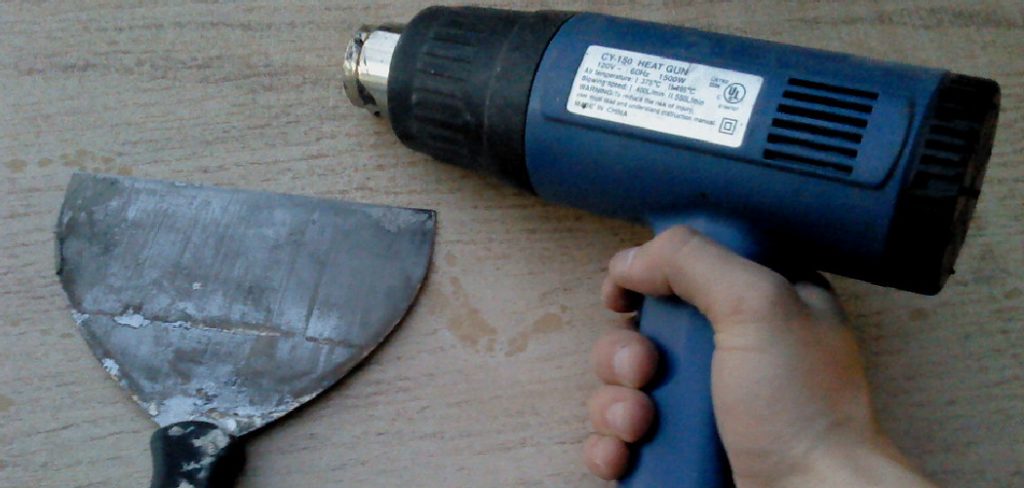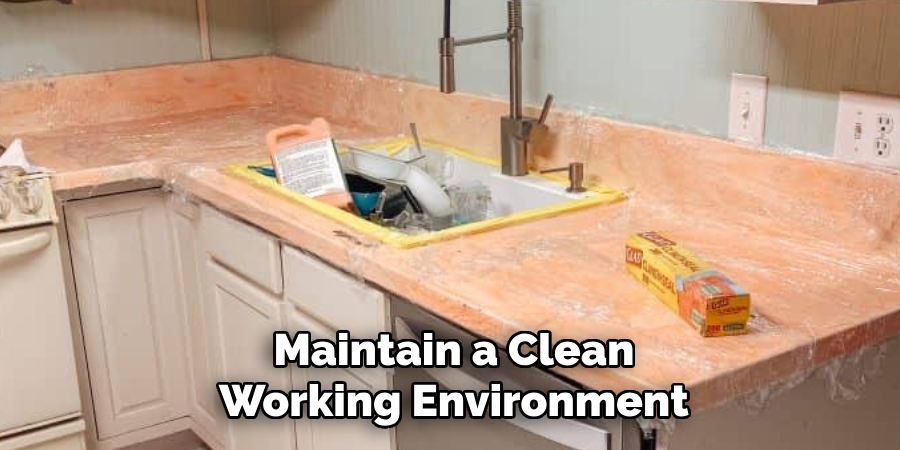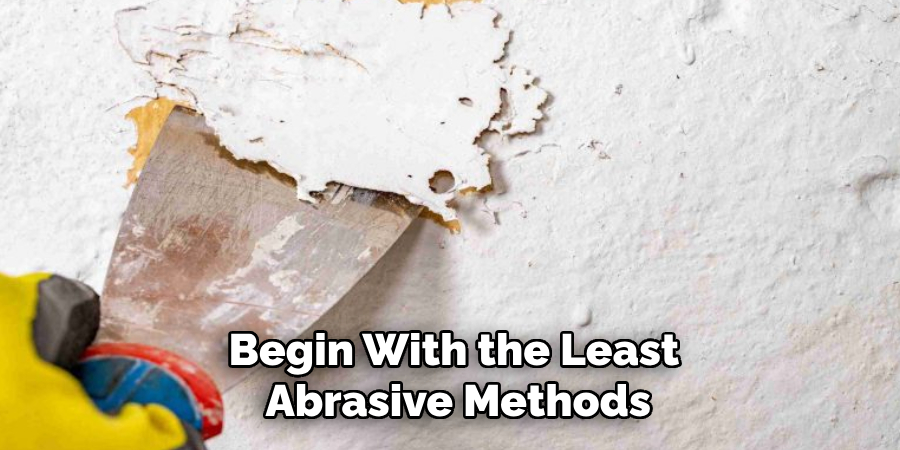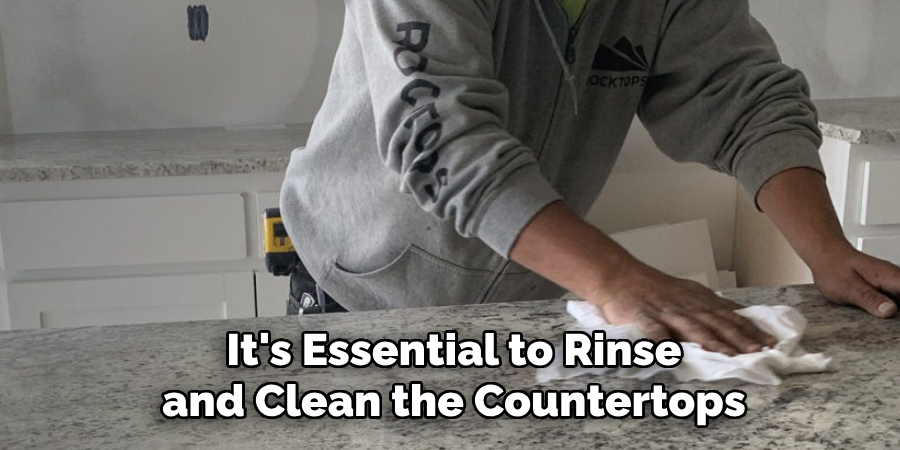Removing paint from painted countertops can be a meticulous task that requires patience and the right approach to avoid damaging the surface underneath. Whether you’re dealing with accidental splashes or an outdated paint job, there are effective methods to restore the original look of your countertops.

This guide on how to remove paint from painted countertops will provide you with step-by-step instructions and tips to safely and efficiently remove unwanted paint, ensuring your countertops regain their pristine appearance without incurring unnecessary damage. Before you begin, it’s critical to understand the materials involved and to gather the appropriate tools and solvents for the job.
Why Remove Paint from Painted Countertops?
Removing paint from painted countertops is often necessary for several reasons. Firstly, old or chipped paint can contribute to an unappealing and dated appearance, significantly detracting from the overall aesthetics of your kitchen or bathroom.
Over time, paint can also begin to degrade, leading to peeling and flaking, which may pose a hygiene risk by trapping dirt and bacteria. Furthermore, if you’re considering selling your home, freshly restored countertops can enhance the property’s appeal and potentially increase its market value. Lastly, removing the paint can reveal and preserve the original materials of the countertop, allowing you to enjoy the natural beauty and texture of surfaces like granite, marble, or wood.
Needed Materials:
Protective Gear:
Before you begin the paint removal process, it’s essential to wear protective gear such as gloves and a face mask to prevent any skin or respiratory irritation from the solvents used.
Tools:
The tools you’ll need may vary depending on the type of countertop material and the type of paint. However, some standard tools include a paint scraper, sandpaper (fine grit), a putty knife, and a plastic sheet or tarp to protect surrounding surfaces.
Solvents:
The type of solvent required will depend on the type of paint used. For oil-based paints, mineral spirits or turpentine are effective options. For water-based paints, warm soapy water is often enough to loosen the paint. In more stubborn cases, a chemical paint stripper may be necessary.
8 Simple Step-by-step Guidelines on How to Remove Paint From Painted Countertops
Step 1: Prep the Area Around the Countertops

Before starting the paint removal process, it’s crucial to prepare the area around the countertops to prevent any damage to surrounding surfaces and to maintain a clean working environment. Start by removing any items from the countertop and adjacent surfaces, including appliances, decor, and utensils. Next, cover the surrounding areas and the floor with plastic sheets or tarps to protect them from spills and splatters.
Secure the edges of the plastic with tape for added protection. Additionally, ensure the room is well-ventilated by opening windows or using fans, as some solvents and strippers may emit strong fumes. Taking these precautionary steps will help create a safe and efficient workspace for paint removal.
Step 2: Identify the Type of Paint on Your Countertops
Understanding the type of paint on your countertops is crucial for selecting the appropriate removal method and solvent. To identify the paint type, start by examining the countertop surface for any visible labels or leftover paint containers that might provide information. If this is not possible, you can conduct a small test in an inconspicuous area by applying a few drops of rubbing alcohol.
If the paint softens or comes off with ease, it is likely a water-based paint. Conversely, if the paint remains unaffected, it is more likely to be oil-based. Accurately determining the paint type will guide you in choosing the best product for the job, ensuring efficient removal without unnecessary damage to the surface underneath.
Step 3: Start With Gentle Methods

Once you have identified the type of paint on your countertops, it’s advisable to begin with the least abrasive methods to preserve the integrity of the surface beneath the paint. For water-based paints, try using a soft cloth soaked in warm, soapy water, gently rubbing the area in a circular motion to see if the paint begins to lift. If the paint shows signs of loosening, continue this method until all the paint is removed. For oil-based paints, begin with a cotton ball or a soft rag slightly dampened with vegetable oil or mineral spirits, which may help soften the paint for easier removal.
Test these methods in a small, hidden area first to ensure they do not damage the countertop material. If these gentle techniques prove effective, diligently work across the entire painted area, and be sure to wipe any residues with a clean, damp cloth to prevent streaking or further adherence.
Step 4: Use a Paint Scraper or Putty Knife for Stubborn Areas
If the previous methods are not effective, you may need to use stronger tools such as a paint scraper or putty knife. These tools can help remove stubborn paint without causing damage to the countertop material.
However, it’s crucial to use them carefully and avoid applying too much pressure, which can cause scratches or gouges on the surface. Begin by gently scraping off any visible excess paint until you reach the original countertop material. Follow this method only if necessary and with caution.
Step 5: Consider Chemical Strippers for Tough Paints

In cases where gentle methods and tools have proven ineffective, you may need to resort to using chemical paint strippers. These substances contain powerful ingredients that can dissolve and loosen the toughest paints. However, they can also cause damage to your skin and surfaces if not used correctly. Before applying a chemical stripper, ensure you are wearing protective gear and carefully follow the manufacturer’s instructions.
Apply the stripper evenly over the painted surface, leave it on for the recommended time (usually 15-30 minutes), then use a putty knife or scraper to remove the paint gently. Once all the paint is removed, wipe down the countertop thoroughly with a clean cloth dampened with water or mineral spirits.
Step 6: Sand Away Residue Marks
After removing the paint, you may notice some residue marks on the countertop surface. These can be easily removed by lightly sanding the area with a fine-grit sandpaper. Be sure to sand in a circular motion to avoid creating scratches or grooves on the surface. Once all residue marks are gone, wipe down with a clean cloth and mineral spirits to remove any remaining debris.
But be cautious of sanding too much, as this can affect the finish or shine of your countertop.
Step 7: Rinse and Clean Thoroughly

After completing the paint removal process, it’s essential to rinse and clean the countertops thoroughly to remove any remaining chemicals or debris. Use a damp cloth with warm, soapy water to wipe down the surface, followed by a final wipe with a clean, damp cloth. Be sure to dry completely before using your countertops again.
The use of a mild cleaning solution can also help remove any lingering odors from the paint removal process.
Step 8: Apply a Protective Coating
Finally, to prevent future spills and damage, consider applying a protective coating to your countertops after removing the paint. This could be in the form of sealant or wax, depending on the material of your countertops. These coatings will provide an extra layer of protection against stains and scratches while also enhancing the appearance of your countertops.
Following these simple steps on how to remove paint from painted countertops will ensure a safe and effective paint removal process for your painted countertops. Remember to always take precautionary measures and test any methods or products on a small, inconspicuous area before using them on the entire surface. With patience and careful handling, you can restore your countertops to their original state and enjoy a fresh new look in your kitchen or bathroom. Happy painting!
Frequently Asked Questions
Q: Can I Use the Same Method for All Types of Countertops?
A: No, it is essential to identify the type of countertop material before beginning the paint removal process. Different materials may require different methods and products for effective and safe paint removal. For example, granite or stone countertops may be more susceptible to damage from chemical strippers and may require gentler methods. It’s important to research the best practices for your specific countertop material before starting.
Q: Is it Safe to Use Chemical Strippers?
A: While chemical strippers can be effective in removing tough paint, they can also be hazardous if not used correctly. Be sure to read and follow the manufacturer’s instructions carefully, wear protective gear, and work in a well-ventilated area. If possible, try gentler methods first before resorting to chemical strippers.
Q: Can I Remove Paint from Countertops Myself, or Should I Hire a Professional?
A: It is possible to remove paint from countertops yourself, but it’s essential to take precautionary measures and be cautious throughout the process. If you are not confident in your abilities or are worried about causing damage to your countertops, it may be best to hire a professional who has experience with paint removal for your specific countertop material. Always weigh the cost of hiring a professional versus the potential damage that could occur by doing it yourself. Safety is always the top priority.
Conclusion
Removing paint from countertops can be a daunting task, but with the right tools, methods, and precautions, it can be done effectively and safely. Always begin with the gentlest approaches and escalate to more aggressive techniques only if necessary. It’s crucial to know the material of your countertop to ensure you are using the right products and tools to avoid any damage. By following the recommended steps on how to remove paint from painted countertops and taking care to protect your surfaces, you can restore your countertops to their original beauty.
Furthermore, applying a protective coating post-cleaning not only enhances the look but also adds an extra layer of defense against potential future mishaps. Remember, patience and careful handling are key to successfully removing paint without compromising the integrity of your countertops.
Check it out: How to Take Care of Marble Countertops
Huston Douthit is a distinguished figure in the world of furniture design, with a decade of expertise creating innovative and sustainable furniture solutions. His professional focus lies in merging traditional craftsmanship with modern manufacturing techniques, fostering designs that are both practical and environmentally conscious. As the author of Fruniturix, Huston delves into the art and science of furniture-making, inspiring artisans and industry professionals alike.
Education
- RMIT University (Melbourne, Australia)
Associate Degree in Design (Furniture)- Focus on sustainable design, industry-driven projects, and practical craftsmanship.
- Gained hands-on experience with traditional and digital manufacturing tools, such as CAD and CNC software.
- Nottingham Trent University (United Kingdom)
Bachelor’s in Furniture and Product Design (Honors)- Specialized in product design with a focus on blending creativity with production techniques.
- Participated in industry projects, working with companies like John Lewis and Vitsoe to gain real-world insights.
Publications and Impact
In Fruniturix, Huston shares his insights on furniture design processes, materials, and strategies for efficient production. His writing bridges the gap between artisan knowledge and modern industry needs, making it a must-read for both budding designers and seasoned professionals.


